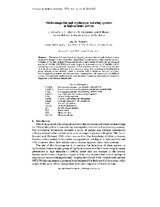Mostrar el registro sencillo del ítem
Methaemoglobin and erythrocyte reducing systems in high-altitude natives
| dc.contributor.author | Arnaud, J | |
| dc.contributor.author | Quilici, JC | |
| dc.contributor.author | Gutiérrez, N | |
| dc.contributor.author | Beard, J | |
| dc.date.accessioned | 2019-05-20T15:08:06Z | |
| dc.date.available | 2019-05-20T15:08:06Z | |
| dc.date.issued | 1979 | |
| dc.identifier.uri | http://repositorio.umsa.bo/xmlui/handle/123456789/20504 | |
| dc.description.abstract | Summary. The stress of chronic hypobaric hipoxia present at high altitudes induces a series of adaptive changes in the intermediate metabolism in erythrocytes of high-altitude natives. Aymaras of the high Andean Plateau are shown to have within erythrocytes: (a) increased activity of NADH₂ (GAPDH) generating stages, (b) decreased activity of NADH₂ (LDH) consuming steps, (c) significantly increased methaemoglobin content, and (d) a large increase in the level of reduced glutathione. These alterations occur also in persons of the same ethnic group residing at low altitude. There is, however, only a moderate elevation of classic haematological parameters (erythrocyte count, haemoglobin and haematocrit) in highland natives. The functional implications of these metabolic changes are discussed with respect to regulation of erythrocyte metabolism. | es_ES |
| dc.language.iso | en | es_ES |
| dc.publisher | Annals of Human Biology | es_ES |
| dc.subject | METAHEMOGLOBINA | es_ES |
| dc.subject | ALTURA | es_ES |
| dc.subject | NATIVOS DE GRAN ALTURA | es_ES |
| dc.title | Methaemoglobin and erythrocyte reducing systems in high-altitude natives | es_ES |
| dc.type | Article | es_ES |

